Natural Metal Finish Paint Systems Test
By Mike McLeod
TEST PURPOSE
To evaluate the compatibility, suitability, use characteristics, and resulting fidelity of "natural metal finish (NMF)" replication for combinations of selected, readily available commonly used silver paint and paint systems (otherwise known as "metalizers") when applied over various types of base/primer coats and/or covered with various clear type paint sealer/top coat finishes.
TEST SCOPE
The scope of this test was limited to those types of paint, which can be reasonably referred to as metalizers, in that they attempt to or are suitable for, replicating the look of bare, unmodified metals. While some non-metalizer type paints were used in base coat and priming, the major focus is on how well the applied silver "metalizer" paint performed. Likewise, various clear finishes were applied over metalizers to determine the characteristics and stability of the over-coated metalizer finish. ALCLAD II type metalizers were tested for compatibility and suitability with various base primers then subjected to testing for ability to withstand aggressive masking tape application and removal. A test was also performed to evaluate characteristics of polyvinylacetate (PVA) for use in masking on bare (not dipped in Future floor wax) plastic.
LIMITATIONS TO SCOPE OF TESTING
While the overall number of combinations and permutations achieved during this test is significant, only a small sample of all the commercially available metalizer products was used. With many different metalizer shades and tones currently in production, only four types of ALCLAD II, five types of enamel, and six types of lacquer were tested. No clear coats were applied to any of the ALCLAD II samples during this test. Some paint systems specify a type of clear coat or sealer and a select few were used in the test matrix per the manufacturer recommendations. The general finish of the samples is of lower quality than would be expected on a model due to the excessive handling and repeated masking required to airbrush the rows and columns of paint on each test card. Some unforeseen pitting of the plastic test cards occurred during spraying on card number three for an undetermined reason. This pitting degraded the surface smoothness a bit and the underlying plastic substrate remains slightly soft to this day. This pitting problem was limited primarily to three specific enamel paints and did not adversely affect results. Being a somewhat relative term, when discussing the group of silver paints used in this test, the context of "color" refers to the relative darkness and variable-shaded tone the paint tends to show. Referring to reflectance, brilliance, or shine is an indication of the final product's ability to act like a mirror. "Wetness" refers to the final surface look, not related to color or reflectance, as if the surface appears to have a layer of shiny viscous fluid covering it.
MATERIALS
With a host of various paints available, a system of abbreviations was used to identify and categorize the materials in used in this test. The following lists the major abbreviations:
- MM Testors Model Masters Enamel
- TS Testors "small square" bottles, ¼ ounce each
- BF Testors Model Masters buffing metalizer lacquers
- NB Testors Model Masters Non-Buffing metalizer lacquers
- SNJ The SNJ spray and powder system
- PS Polyscale
- TM Tamiya
The following lists categorize the paints used by type, finish, make, manufacturers serial/stock number, and color description (Note: The TS Aluminum had lost its label and the stock number is unknown):
| GLOSS | FLAT | SILVERS | CLEAR COAT |
|---|---|---|---|
| MM 1747 Black | MM 1749 Black | SNJ 1320 Spray Silver | MM 2736 Gloss Clear |
| TS 1145 White | MM 1768 White | MM 1790 Chrome Silver | |
| TS 1111 Dark Blue | MM 1163 Gray | TS 1146 Silver | |
| TS 1110 Blue | TS 1185 Rust | TS 1180 Steel | |
| TS 1133 Brown | TS ? Aluminum |
| NON-BUFFING | BUFFING | CLEAR COAT | ALCLAD II |
|---|---|---|---|
| NB Aluminum | BF Titanium | Testors Metalizer Sealer | (B) Duraluminum |
| NB Steel | BF Magnesium | (E) Polished Alum. | |
| BF Burnt Steel | (F) White Alum. | ||
| BF Aluminum Plate | (G) Chrome |
| CLEAR COAT |
|---|
| PS F404100 |
| TM X-22 |
In addition to the listed paints, the manufacturers recommended thinners were used. All paint was applied with a Pasche H-3 type single action airbrush on a D-500 compressor with regulator/water trap and extra in-line water trap. 3-M brand blue masking tape and commercially purchased PVA was used for masking. The ALCLAD II test card was made of Evergreen brand 1/8th inch thick white styrene. The other five test cards were obtained by cutting out the dividers from a desktop letter holder made of a hard, dark smoke colored plastic, the type of which is unknown. Apparently this non-styrene plastic reacted adversely to some solvents and paint, as previously mentioned for test card #3.
PROCEDURES
The five small test cards were prepared first. Paints desired for testing were arranged and sorted by type and color. The test cards were prepared by scribing lines both vertically and horizontally to demarcate a matrix, either 4x4 (cards 1 through 3) or 3x4 (cards 4 and 5). On each card a specified type of paint was applied along a horizontal row. Once cured, various clear coat finishes and/or sealers were applied along the vertical rows. To further expand the combinations available, some vertical rows were allowed to overlap and place various clear finishes on top of each other in a layered application. To set a control for each test card, the far left column was never top coated with anything and the bare, untreated "metalizer" was allowed to remain. Since the SNJ system does not actually use silver paint, rather a silver powder on top of a base coat, the respective horizontal rows were base primed using different gloss (card 1) and flat (card 2) colors before the SNJ powder was rubbed into the surface of the partially cured paint. Silver Rub-n-Buff was applied to the far right edge of several test cards on top of fully cured clear coats, and in turn allowed to cure. Where MM metalizer lacquers had sealer and clear coat applied, the MM metalizer sealer was applied before the clear coat, and allowed to cure. The reverse side of card 4 was used to test PVA as a liquid mask agent. Some lines were scribed and various patterns of mask were painted on the surface with a fine tipped brush and allowed to dry, before a coat of NB Aluminum was applied.
The ALCLAD II data card was prepared in a separate operation after the first five data cards had been completed. A strip of 1/16th inch thick Evergreen styrene was marked to have 13 columns and five rows. The lower four rows were of similar width, and the upper row left as a thin strip to be unpainted by the ALCLAD II, leaving a visual indication of the type of base primer used in each column. Before the base primer columns were painted, various surface details were scribed and etched into the surface. This was to allow later evaluation of the ALCLAD II system's ability to accentuate (or attenuate) scribed panels or rivets. When all the columns of base primer were painted and cured, four rows of ALCLAD II were applied along the length of the test card. After allowing approximately one hour of cure time, masking tape was applied over the ALCLAD II, firmly burnished down, and immediately peeled up to evaluate the base primers ability to bond the ALCLAD II to the substrate and/or base primers.
TEST CARD PREPARATION
Refer to attached pictures of each data card and the matching data card map which details the specific paint matrix applied.
DATA CARD 1: SNJ powder rubbed into partially cured gloss enamel base, various clear coats.
From top to bottom, the four rows of gloss base coats used were 1747 black, 1111 blue, 1133 brown, and 1145 white. From left to right, the five columns of clear coats used were none, metalizer sealer, MM 2736 clear, PS F404100 clear, TM X-22 clear.
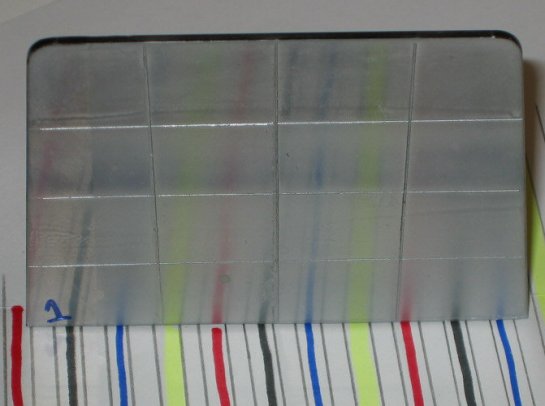
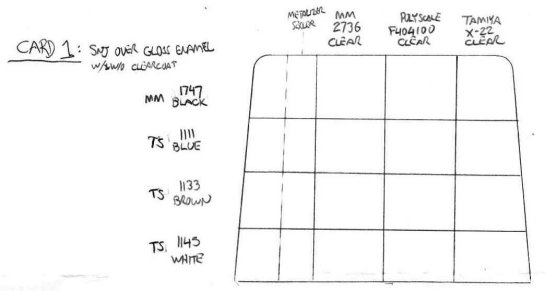
DATA CARD 2: SNJ powder rubbed into partially cured flat enamel base, various clear coats.
From top to bottom, the four rows of flat base coats used were SNJ spray aluminum, MM 1749 flat black, TS 1185 flat rust, MM 1762 flat white. From left to right, the five columns of clear coats were applied in the same manner as on data card 1. When fully cured, a thin band of silver Rub-n-Buff was applied and buffed smooth along the far right edge of the test card and allowed to cure.
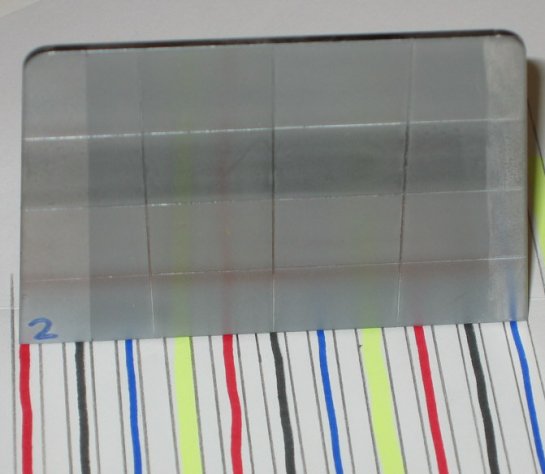
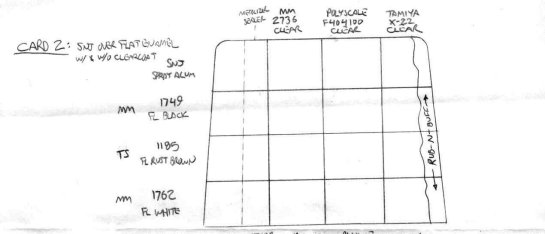
DATA CARD 3: Silver enamels without SNJ powder, various clear coats
From top to bottom, the four rows of silver used were MM 1790 chrome silver, TS 1146 silver, TS ? aluminum, TS 1180 steel. From left to right, the five columns of clear coats were the same as used on data card 1. When fully cured, a thin band of silver Rub-n-Buff was applied and buffed smooth along the far right edge of the test card and allowed to cure.
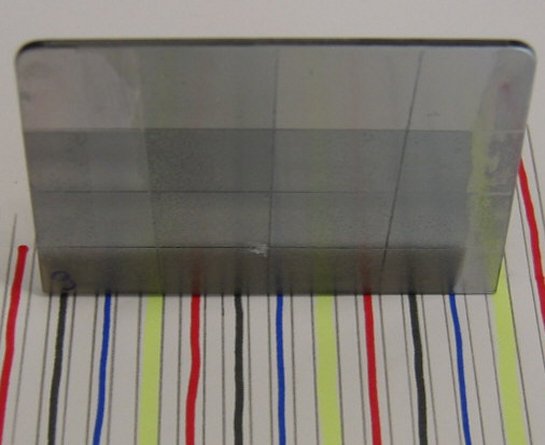
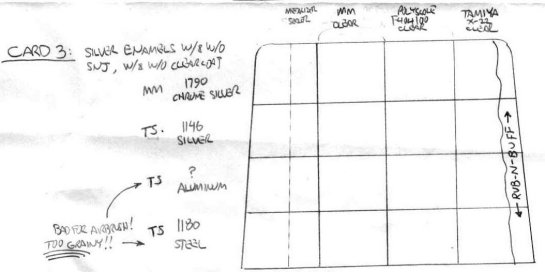
DATA CARD 4:BF and NB metalizers (light colors) with and without metalizer sealer, various clear coats.
From top to bottom, the three rows of metalizer lacquers were BF aluminum plate, NB steel, and NB aluminum. Next, the right half of the first column and the entire second column were sealed with metalizer sealer and allowed to cure. Clear coats were applied as follows: left half of second column - MM 2736 clear, right half of second column and left half of third column - TM X-22 clear, right half of third column - MM 2736 clear, fourth column - PS F404100 clear. The left half of the first column was left untreated on all three rows. When fully cured, a thin band of silver Rub-n-Buff was applied and buffed smooth along the far right edge of the test card and allowed to cure. Test card 4 was reversed and series of overlapping lines and circles were scribed into the surface. Liquid PVA was applied in specific patterns with a fine tipped sable brush both within the scribed line boundaries and in free-hand patterns. Once the PVA was dry, NB aluminum was sprayed over the entire area, allowed to dry, and the PVA removed with sharp, needle tip tweezers.
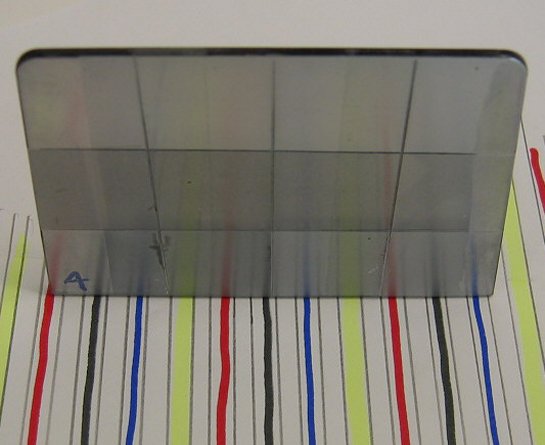
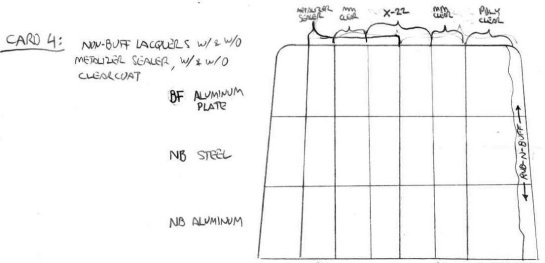
DATA CARD 5:BF metalizers (dark colors) with and without metalizer sealer, various clear coats.
From top to bottom, the three rows of MM metalizer lacquers were BF burnt metal, BF magnesium, BF titanium. From left to right the seven columns of metalizer sealer and clear coats were applied in the same manner as on test card 4.
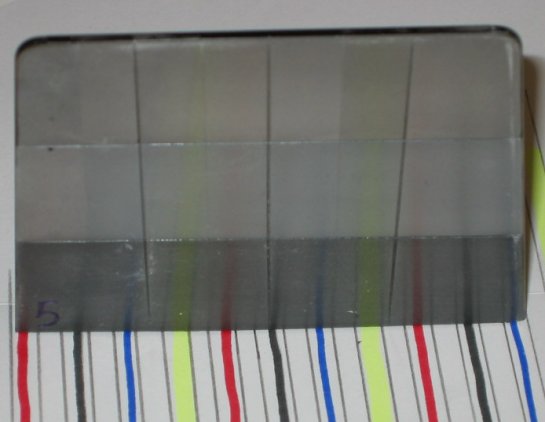
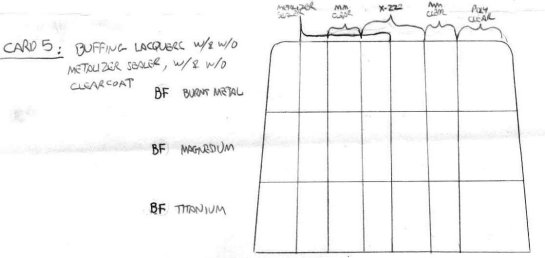
ALCLAD II DATA CARD: Gloss, flat and silver enamels, NB lacquer, and both enamel and acrylic based clear coat base primers under four colors of ALCLAD II.
The test card was marked to have 13 equal width columns and equal width ALCLAD II rows, with an allowance at the top so that a small sample of the underlying base primer will remain visible. Scribing templates and pounce wheels were used to apply some notional panels and rivet lines. The columns of base primer were masked such that every other column was painted, then allowed to cure. Once cured and safe to mask over, the remaining areas in between were masked, painted, and allowed to cure. From left to right the 13 columns of base primer were as follows: TS 1145 white, TS 1110 blue, TS 1111 dark blue, TS 1133 brown, TS 11747 black, TS 1146 silver, MM 1762 flat white, MM 1163 flat gray, MM1749 flat black, NB aluminum, MM 1790 chrome silver, MM 2736 clear top coat, and TM X-22 clear. The base primers were set aside for several days to cure then four rows of ALCLAD II were applied. From top to bottom the four rows of ALCLAD II were (B) duraluminum, (F) white aluminum, (E) polished aluminum, (G) chrome.
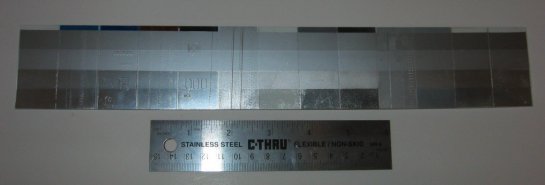
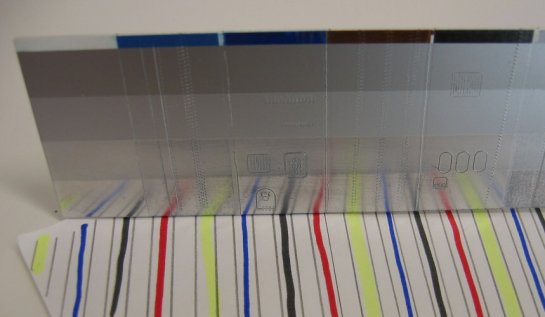
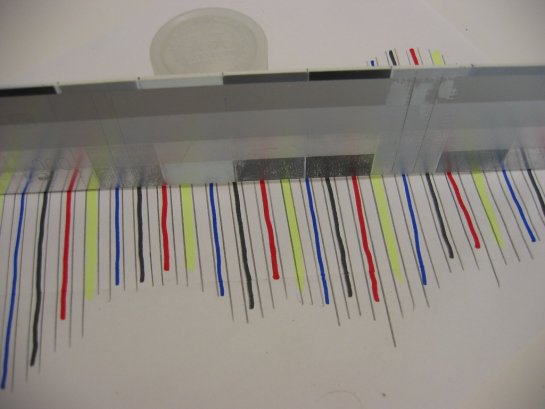
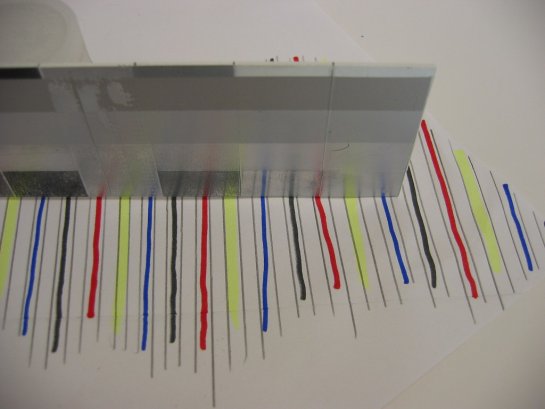
DATA CARDS
Photos of the data cards were taken with a Cannon S30 4-meg digital camera set on AUTO, no flash. Lighting was from an overhead two-bulb florescent shop light with camera oriented to look-down upon the test cards which were laying flat on white poster board. Shooting area was in large 2-bay garage, 20 feet from the open door with bright diffuse natural light coming in, as sky conditions at the time were scattered clouds with bright sun, and distinct shadows visible. Test cards were photographed on a color striped (thin pencil lines and thick marker color lines) sheet to allow surface smoothness and reflectance differences to be readily visible as well as providing a visual color reference to assess "color" of the metalizers.
ALL DATA CARDS

PVA MASK
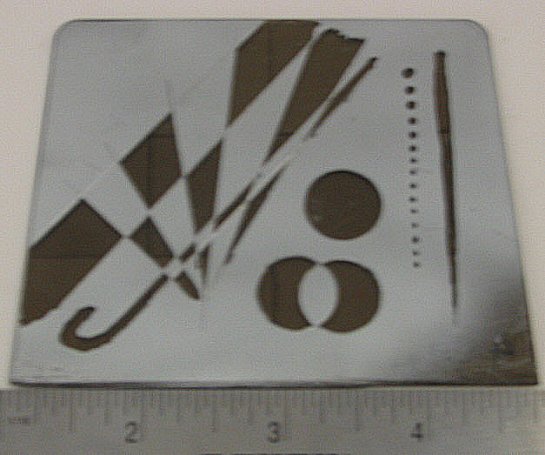
RESULTS
SNJ powder rubbed into gloss enamel produces a very shiny smooth surface but on flat enamel gives a dull metal appearance. Different gloss bases have no readily perceptible affect on the SNJ surface color but on flat paint bases the SNJ seems to fill in pores and some of the base color high spots show through giving a very slight color tone from the base color to the dull SNJ surface. On gloss base SNJ, applying metalizer sealer kills the brilliant shine and reduces the SNJ finish to the equivalent of NB aluminum. Metalizer sealer on flat based SNJ gives the surface a slightly darker, richer color and a very slight sheen while stabilizing the surface and protecting it from handling smudges, dirt, and discoloration. Enamel clear over gloss based SNJ will not affect surface reflectance and gives a shine more indicative of a "wet" dull metal surface than a shiny, polished metal surface. Likewise, enamel clear over flat base SNJ stabilizes the flat silver surface does not affect reflectance and imparts a "wet" look. The PS F404100 clear performs similarly to the clear enamel on both types of SNJ bases however on the gloss it leaves a very "wet" look while on the flat based SNJ it leaves a semi-gloss, less "wet" look with a very smooth surface. The TM X-22 clear performed very much like the PS F404100 with a less "wet" look on the gloss base and similar "wetness" look on the flat base. Additionally it had a unique quality when viewed under a direct point-source light (single bright bulb or direct sunlight). In these lighting conditions the surface was smooth yet has a detectable level of "sparkle" when shifting the piece around, as if the surface is a rough, crystalline structure at a microscopic level.
Test card 3 had some unusual reactions with the clear coats over the TS silver colors. The MM 1790 chrome silver held up well, but the other three (TS silver, aluminum, and steel) colors became severely pitted in spots when applied. Where metalizer sealer was applied over the three TS paints that eventually pitted, the sealer appears to have stabilized the underlying plastic or arrested the agent attacking the plastic. The right half of the first column of card 3 had the sealer peel away in a very thin layer when the masking tape was removed. However, the remaining silver, aluminum, and steel paints seem to have been positively affected by the sealer. Despite loosing the sealer, the surfaces remained smooth and stabilized against dirt and smudges, and do not show any signs of the pitting which occurred in all the other columns on card 3 where the TS paints were applied. The reason for this is unclear as the same solvents and thinners were used as on other samples. One item that did seem to indicate a unique quality of the pitted areas is that those specific TS enamels replicate metals and are very "grainy" paints and do not spray well with the airbrush. These may be formulated with a different carrier solvent base and reacted to the type of plastic in an adverse way. This may be unique to this type of plastic and not an issue with styrene. The metalizer sealer (made to cover lacquer based BF and NB lacquers) did not adhere well at all to any of these four types of enamel silver paint. After lifting the masking tape virtually all the metalizer sealer peeled away, yet had somehow reacted with the surface to protect and stabilize it. The other clear coats applied performed very similarly to the way they did on test cards 1 and 2. The surface reflectance and brilliance was unchanged and the samples were left with varying degrees of a "wet" look. The clear enamel looks the wettest, the X-22 slightly less wet looking than the enamel, and PS 404100 moderately wet with a much smoother surface finish than the other two. The Rub-n-Buff applied to the right edges of test cards 2,3,and 4 is a waxy paste that goes on somewhat heavy and must be rubbed in well. It fills in pitted areas of flat paint well but tends to get too thick on smooth areas. Rub-n-Buff stays soft and waxy for a very long time and even when "hardened", is still soft enough to scrape off with gentle fingernail pressure and will flake off if picked with a sharp object. It apparently out-gasses some of its solvents and leaves behind a silver colored wax base whose metal replication properties are not good and very dependent on having a very perfect base.
Metalizer lacquers perform well when sprayed and appear to be compatible with almost any clear coat applied, individually or in layers. The manufacturer recommended Testors metalizer sealer tends to reduce the surface brilliance of the paint, slightly lightens the BF aluminum plate, does not affect the NB steel, and slightly darkens the NB aluminum. In all cases the metalizer sealer bonded well and stabilized the surface, while giving a protective barrier to dirt and smudges, and imparted a slight sheen and minimal, if any, "wet" look. The other enamel and acrylic clear coats performed unremarkably and similarly to previous test cards. The highest shine and thickest coat were from the MM 2736 clear giving a very "wet" look. The TM X-22 was similar but less wet looking, and the PS F404100 added some additional wetness and consistently had the smoothest final surface finish. The PS F404100 performed almost identically to the metalizer sealer except it imparted a slightly "wet" look.
Applying the series of clear coats on the BF metalizers with dark colors on test card 5 yielded nearly identical results as those obtained on test card 4 with light colored metalizers. The manufacturer recommended metalizer sealer performed well and protects the paint from dirt, smudges, and fingerprints without any appreciable change in color or tone and a minimal addition of "wetness". All other combinations of clear coats were compatible and no detrimental or unusual characteristics were noted. Again, the PS F404100 seems to have the best qualities for coverage and self-leveling to yield a very smooth surface.
The ALCLAD II lacquers are very "hot" as far as paints go, meaning that they have very volatile carriers, which evaporated quickly allowing the paint to cure in a few minutes. These "hot" paints can also attack bare plastic if sprayed on wet and the volatiles remain on the surface too long. While the different ALCLADS look similar, their chemical makeup appears to be very different from one set of colors to the next. All types tested proved very tenacious and bonded strongly to any base primer tested. The white aluminum (F) and duraluminum (B) had very stable color and surface brilliance characteristics on all base primers and showed a marginal increase in shine for gloss base compared to flat base primer. The polished aluminum (E) and chrome (G) are totally dependent on their base primer for their reflectance characteristics. When applied over gloss enamels or gloss acrylics, (E) and (G) produce a very shiny, mirror like surface that is tough and ready to mask in minutes. However, if applied over flat base primer, (E) and (G) will have little to no reflectance and masking tape will peel the ALCLAD II totally off the surface. This appears to be the result of the silver and flat paints being a more granular type of material whereas the gloss paints set up to be a more homogeneous layer of paint. Either the mid layers of the flat paint are weak, or the solvents in the ALCLADII weaken them, and masking tape pulls apart the base primer flat surface paint lifting most with the ALCLAD II, leaving the primer behind with traces of ALCLAD II on the surface. Since gloss paint is a more viscous type of paint with better self-leveling, it seems to cure up as a homogeneous layer to which the ALCLAD II fully bonds at the surface interface. In a few spots the clear base primer layers did not totally cover the styrene underneath and when the ALCLAD II was sprayed on more heavily it promptly pitted these locations as the volatiles in it quickly attacked the plastic. For this reason it is imperative to apply the ALCLAD II in light mist coats to allow the carriers to evaporate quickly and not have time to attack the plastic. The first couple mist layers will set up a barrier to help keep later mist layers from attacking holes in the primer. This was verified in a few locations where gaps between the gloss primer coats left bare styrene. Carefully misting the ALCLAD II, and not attempting to lay down a wet coat, a full coating was applied on the gloss-primed columns in layers and the bare styrene gaps in between did not pit. The scribed panels and rivets turned out reasonably well and did not cause any problems with surface preparation or paint application. While all ALCLAD II colors performed well on gloss base, only the (B) and (F) were able to stay bonded to the flat base primer when masking tape was removed. Apparently (B) and (F) formulations of ALCLAD II are different, from (E) and (G), and tend to "bite" deeper into the flat paint and do not just lay on the surface, thus creating a stronger total layer of paint able to withstand masking. The exception being NB aluminum lacquer as a base primer which was not able to withstand any masking for any color of ALCLAD II.
COMPATIBILITY
SNJ powder finishes adhere well and stay bonded when rubbed into partially cured gloss or flat enamel paint. All clear coats and metalizer sealer bond with the rubbed SNJ surface well.
Rub-n-Buff adhered well to the surfaces where it was applied. No particular preparations were required before applying it and it does not seem to react adversely with the underlying surface of TM or PS acrylic clear.
Metalizer sealer does not appear to bond well to enamel base silver paint, yet other clear coat enamels and acrylics bond well to the those paints without appreciably changing the color or reflectance of the underlying paint. Metalizer sealer is excellent at stabilizing the surface and protecting from handling and masking damage for all types of paint tested. Despite peeling away from the surface on enamels, the metalizer sealer still left some degree of protection and stabilized the surface. Various permutations of clear coat enamel and acrylic layers applied over the BF and NB metalizers all seem to be compatible.
The smoother and shinier the base primer, the better the final results of the ALCLAD II that goes over it. All ALCLAD II performed well when applied over gloss enamel, clear enamel, or acrylic bases and did not show any tendency to peel up when masked over. ALCLAD II (E) and (G) do not resist masking well over a flat paint or chrome silver enamel base coat, but (B) and (F) seem to cover well and bond to those surfaces, and did not lift when masking tape was pulled off. Non-Buffing lacquer type paints are not compatible with ALCLAD II at all. The NB type paints seem to have a surface layer of granular paint to which the ALCLAD II bonds. When masked, the surface layer of the NB paint will separate from the base layer and allow any type of ALCLAD II to lift away.
Using plain PVA as a liquid masking agent on bare plastic works well with NB aluminum metalizer. PVA as a masking agent worked well on bare plastic but its performance on other surfaces was not evaluated. The PVA can be applied accurately onto areas bounded by scribed panel lines or carefully free handed in a desired area. PVA, a water based rubbery compound, dries quickly and does not show any adverse reactions to the paint or solvents used when over sprayed. Dried, painted PVA peels up easily and leaves a clean, sharp edge. The masking performance of PVA is not affected by the relative area covered from very small 2-3 mm dots up to larger circular or rectangular areas with very acute angles at the corners.
SUITABILITY
On gloss base the SNJ takes on a brilliant shine while on flat base it remains dull and tends to show a tone of the flat paint base primer color through. Metalizer sealer applied over SNJ reduces the finish qualities to that of BF aluminum plate and stabilizes the surface. Clear coats applied over the SNJ do not appreciably change the surface reflectance and tend to give the surface a "wet" look.
Clear enamels and acrylics applied over certain enamel base paints will leave varying degrees of "wetness" on the finish. Predominantly, enamel clear coat lays on the thickest and gives a somewhat smooth, very "wet" looking finish. TM X-22 clear acrylic is not as thick as enamel and leaves an equally smooth, but less "wet" looking finish. PS F404100 acrylic clear has the best self-leveling properties of all tested clear coats and leaves the most smooth, least "wet" finish.
BF and NB metalizer lacquers provide excellent bonding and a smooth finish in their respective colors, yet are not capable of providing a high reflectance surface. On the darker BF metalizer colors the sealer has little effect on the color or surface reflectance. On the lighter colors of NB and BF metalizer the sealer tends to offset the color a bit and slightly reduces the surface reflectance. The major variations in final surface qualities seem to be dependent on the last clear coat applied. The thickest and highest gloss (most "wet" looking) finish was obtained from enamel, followed by TM X-22 with a less thick less "wet" look and in certain cases a somewhat "sparkly" finish. The smoothest finish was obtained from PS clear acrylic and it had the least level of "wetness" for a clear coat.
There is a marginal, barely perceptible change in the tone of color on ALCLAD II (E) and (G) when applied over different gloss base primers, however the darker gloss bases looked the best. For practical purposes, any gloss enamel or acrylic base primer will provide adequate results and finish quality for the ALCLAD II colors tested.
The surface qualities of Rub-n-Buff were inferior to any of the paint or paint systems tested. The thick, waxy paste will rub into the surface and adhere but tends to fill in low spots on flat paint or a rough surface. This allows much of the underlying surface to show and gives a distracting, non-uniform appearance. While coverage is better and more consistent on a glossy smooth surface, the thick waxy paste tends to have a streaky look when buffed into the finish.
CHARACTERISTICS
SNJ finishes have a high reflectance over gloss base, and a dull finish over flat base. The color of the base for SNJ powder has a marginal effect for gloss base, and a significant effect for flat bases. All SNJ finishes are color and reflectance stable under clear coats and take on a level of "wetness" dictated by the type of clear coat used and the heaviness of the application. Applying clear coats or sealer to these finishes protects them from handling damage.
SNJ spray aluminum and silver type enamels provide smooth finishes and are color stable under all clear coats and sealers. Type and heaviness of application of the final clear coat control the level of finish "wetness". Applying clear coats or sealer to these finishes protects them from handling damage.
Various BF and NB metalizers provide very consistent and uniform finishes. The surfaces are very color and reflectance stable for metalizer sealer and clear coats. Applying clear coats or sealer to these finishes protects them from handling damage.Leaving BF and NB paints untreated allows dirt and smudges to work into the surface from normal handling while keeping the surface reflectance low, which may be a desired look. Layering various clear coats on top of metalizer sealer or on the paint directly will vary the "wetness" of the surface without appreciable changes in color or reflectance.
The ALCLAD II paint system provides a very tough, fast drying finish with variable degrees of color and reflectance in a single top layer of paint. The final surface finish characteristics are dependent on the quality of the underlying base primer and the care used in applying the ALCLAD II. Surface details scribed in prior to application of base primers show detail and shape well. Simulated rivets from a pounce wheel tend to look more like holes if not kept very small in size. Scribed hatch and panel details show very vividly once final layer of ALCLAD II is applied. Provided the ALCLAD II is bonded well to a gloss base it can withstand very aggressive masking with tape one hour after application.
The PVA is a viscous, water-based liquid, which dries to form a thin, rubbery film. It is easy to apply and applying the film thicker does not improve its masking properties, but may enhance the ability to peel the entire area of dried PVA off in one piece. However, if applying PVA in by free hand with a brush, it may be difficult to accurately trace a consistent edge as the liquid PVA is a pale light green and very hard to see when being applied. The PVA has unique properties in that it can be applied equally well in very small areas, and/or in very intricate patterns.
FIDELITY OF NMF REPLICATION
With the main objective of applying metalizer paints being the replication of a natural metal finish, certain products, or combinations of products, perform better. The final look being a subjective issue, a given product may perform exactly as designed, yet not provide the desired emulation of the surface. This occurs because some metalizers have rough, porous type surfaces that require a sealer or clear coat to stabilize and protect. This protective layer tends to degrade the paints replication of the surface to varying degrees. Also, applying clear coats (as in preparation for decaling) will impart a "wet" look to the surface that may not be accurate or desirable. Since the metalizers tend to be color and reflectance stable with clear coats, it seems reasonable that a final layer of compatible dullcoat over the glossy clear-coated surface will adequately remedy an excessively glossy finish.
Natural metal exposed to the elements takes on many different, subtle looks that can be replicated by available metalizer paints. Once sealed or clear coated, surface degradations such as dirt, wear, and stains becomes more difficult. Performing desired weathering on the bare paint might be a preferred method to achieve a weathered look before coating to stabilize the surface from additional wear and tear.
SUMMARY
Metalizer finishes come in many types, colors, and degrees of reflectance. The final results obtained from a particular product or combination thereof are very dependent upon the proper surface preparation and correct application of the metalizer products in accordance with manufacturer recommendations. Some departures from the recommended methods and materials may be required for advanced modeling applications. When entering the arena of mixing various media it is imperative that prior testing for, or determination of, compatibility is performed. While some mixed-media combinations and permutations of base coat primers, metalizers, and sealers/clear coats are perfectly compatible; the final resulting finish may not be suitable for what the modeler desired. Metalizers are designed to provide consistent, uniform finishes on a given surface application. This may or may not be the desired intent of the modeler who desires an inconsistent, weathered, or damaged looking surface, which will require some level of advanced finishing techniques. Using metalizers to accomplish this may be achievable if the proper base paints are applied to the surface and careful layering of additional metalizers is executed with a predetermined plan. Likewise, the "poor" bonding qualities of some metalizers on base primers may be exploited to emulate a surface that is flaking away and deteriorating. The vast number of products on the market dictate that the serious modeler research and test specific materials in the desired application methods prior to committing to a project in-work. The range of colors, finishes, reflectance, and sheen available should provide any modeler with adequate finishes to complete any model with suitable accuracy. Replication of real world natural metal finishes is a fine tuned art which demands a keen eye for detail and an inherent ability to choose proper finishing materials. Because of the extensive number of possibilities when choosing the best metalizers for a particular project, it is impossible to lay out any type of meaningful rule-of-thumb. The results achieved will be predicated on the individual modeler's experience and familiarity with proper use of the chosen material.
© Mike McLeod 2002
This article was published on Wednesday, November 04 2015; Last modified on Wednesday, November 04 2015
